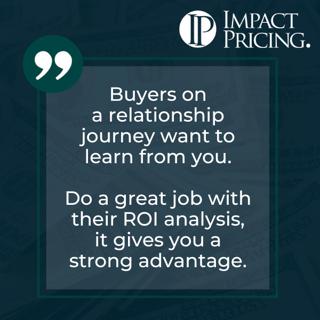
Pricing Table Topics: 9 of Clubs – Buyers on a Relationship Journey want to Learn from You
This one is the 9 of Clubs from the Selling Value card deck. Let's start with, what is a relationship journey? Buyers who are on a relationship value journey realize they have a problem and then they go straight to a salesperson to learn. They didn't spend a whole bunch of time on the internet researching options or alternatives. They're the type of people who would rather learn from someone else, who would rather get the feedback. Let's say your refrigerator just broke down, and your friend says to you, "Hey, you got to go talk to Bob at the appliance store, Bob will help you out." And you walk in and start to talk to Bob. Now, what is Bob's job? Bob should be focused on, how is buying a new refrigerator going to be better for your life? Which style of refrigerator is going to be better for your life? They're truly focusing on the problem that you have and what's the best solution to your problem. They're not focused on saying, here's why my store is better than someone else's store, they're just focused on your problem. If you're in B2B sales, when you find someone who has been recommended to you, your job isn't to sell your product relative to a competitor. It's to sell, here's why solving that problem is so valuable to you. Now, the relationship journey implies that they're going to go on and talk to some of your competitors. The key though is when you have the chance to build the relationship to help your buyer understand the ROI, you've got this strong advantage because (a) they like you, (b) your competitor is probably not helping them with the ROI analysis, and you've demonstrated that you truly understand your buyer's problems. So, absolutely, when someone gets recommended to you or someone comes to you and they're not looking at competitive alternatives, talk about the value of solving the problem. Don't talk about competition. We hope you enjoyed this example of Pricing Table Topics. What you just heard was done without a script. If you want to get better at speaking about pricing and value, grab a deck of our cards, pick a card, read the saying, then talk for one to two minutes about what that card says. You'll become a better speaker and expert. If you have any questions or feedback, please email me, mark@impactpricing.com. Now, go make an impact. Connect with Mark Stiving: Email: mark@impactpricing.com LinkedIn: https://www.linkedin.com/in/stiving/
8 Feb 20232min
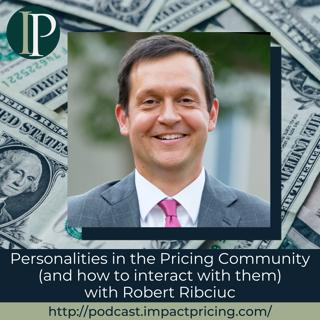
Personalities in the Pricing Community (and how to interact with them) with Robert Ribciuc
For the last ten years, Robert Ribciuc has been working as the Managing Partner of EBITDA Catalyst, helping clients accelerate growth in key valuation metrics. He has a BA in Math and Economics from Harvard and an MBA from Chicago Booth School of Business. In this episode, Robert shares some of his insights on how to deal with different kinds of people in the industry, be it personal or online. Why you have to check out today’s podcast: Get tips on how you could recover and avoid “falls” in your life Learn how to give feedback and criticisms in a nice, positive manner Discover some lesser-known tricks/hints about how the LinkedIn algorithm works “If enough people notice those behaviors in you, that are all about you – selfish, self-promoting, etc., most of the time, when a comment like that is posted, nobody replies or gives any acknowledgment to that kind of comment, and you can just hear in that wall of silence all the people who are mentally walking away from this person just like you described.” – Robert Ribciuc Topics Covered: 01:37 – Pre-recording conversation about the pricing community and the different kind of people in the industry 07:10 – How to deal with people who self-aggrandize 11:46 – The recipe for avoiding the next “thud” in your life 17:06 – Why everyone avoids people who are negative, selfish, and self-promoting 20:42 – Why many people are reluctant to give feedback or criticism 23:24 – How to give feedback in a positive and helpful tone 24:31 – Some helpful LinkedIn tips/hints from Mark Stiving 29:04 – (When posting something) Add something positive to the conversation instead of demeaning the author 30:19 – Connect with Robert Ribciuc Key Takeaways: “Sometimes, pressure brings these behaviors that you and I may be chuckling at and promise ourselves we're not going to be like that.” – Robert Ribciuc “If you remove this artificial constraint we placed on ourselves, like, ‘I got to grow this fast’ or ‘I got to be on this trajectory’ or ‘I got to reach this amount of money’ or whatever, and you just let that balancing act, and rest on what makes you feel most whole and contributing to the world, maybe that's a recipe for avoiding the next thud in your life.” – Robert Ribciuc People / Resources Mentioned: Savvy Self-Promotion (HBR article): https://hbr.org/2021/05/savvy-self-promotion Unreasonable Hospitality: The remarkable Power of Giving People More Than They Expect: https://www.amazon.com/Unreasonable-Hospitality-Remarkable-Giving-People/dp/0593418573 Richard Bliss: https://www.linkedin.com/in/bliss Connect with Robert Ribciuc: LinkedIn: https://www.linkedin.com/in/ribciuc/ Email: robert@ebitdacatalyst.com Connect with Mark Stiving: LinkedIn: https://www.linkedin.com/in/stiving/ Email: mailto:mark@impactpricing.com
6 Feb 202333min

Blogcast: A Nespresso Price Increase
This is an Impact Pricing Blog published on December 21, 2022, turned into an audio podcast so you can listen on the go. Read Full Article Here: https://impactpricing.com/blog/a-nespresso-price-increase/ If you have any feedback, definitely send it. You can reach us at mark@impactpricing.com. Now, go make an impact. Connect with Mark Stiving: Email: mark@impactpricing.com LinkedIn: https://www.linkedin.com/in/stiving/
3 Feb 20232min

Pricing Table Topics: 9 of Hearts – The Most Common and Least Attractive Buyers
This one is the 9 of Hearts from the Selling Value card deck. It is true that buyers on an analytical journey are very price sensitive. Buyers on an analytical journey are probably the way you and I shop most of the time, and so it's the most common type of buyer's journey. These buyers are the ones who realize they have a problem, let's say, their refrigerator broke down. Then what do they do? They do a bunch of research to figure out what's the best refrigerator to replace the one that just broke. They know they need to go buy one, but they're on the internet looking at a whole bunch of different brands, maybe different technologies, styles, sizes, colors, and by the time they walk into a store, or two, or three, they've got a great feel and they're comparing, “Hey, how is this one better than that one?” These are really price sensitive buyers because they've identified what are all the different possibilities and they can trade off, “Oh, do I want water in the door, or ice in the door,” and, “What's that extra cost going to be?” And, “Oh, this brand is so much better than that brand,” and, “How much more am I willing to pay for it?” Price becomes a really big part of their purchase decision. Sadly, we have to deal with these, and we deal with these the way that they come and expect and ask questions, and we want to find an answer. But the real goal is to be able to identify the other types of buyer's journeys so that we have the ability to capture more revenue from them. We hope you enjoy this example of Pricing Table Topics. What you just heard was done without a script. If you want to get better at speaking and about pricing and value, grab a deck of our cards, pick a card, read the saying, and then talk for one to two minutes about what that card says. You'll become a better speaker and expert. If you have any questions or feedback, please email me, mark@impactpricing.com. Now, go make an impact. Connect with Mark Stiving: Email: mark@impactpricing.com LinkedIn: https://www.linkedin.com/in/stiving/
1 Feb 20232min
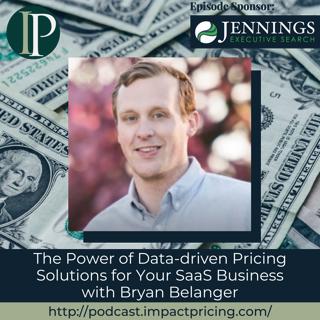
The Power of Data-driven Pricing Solutions for Your SaaS Business with Bryan Belanger
Bryan Belanger is the senior director of Technology Business Research. He's also the senior director at XaaS Pricing, a subsidiary of TBR that helps SaaS companies price on a data-driven approach. In this episode, Bryan talks about the work that XaaS Pricing does and who their target customers are. He also shares his insights on other business and pricing models and how you could choose which one works best for your business. Why you have to check out today’s podcast: Find out who XaaS Pricing are and how they might be able to help with your business Learn how to create a simple yet effective business framework by talking to your customers Get insights on the current trends such as usage-based pricing and product-led growth “Create a simple framework that works for you. For me, it's probably talk to ten customers; and that, I think, can help you. I think the hardest part is often knowing where to start or what you're even trying to solve for is. So, find a framework that works for you, that focuses on talking to your customers and asking these questions, and let it snowball from there.” – Bryan Belanger Topics Covered: 01:51 – How Bryan got into pricing 02:56 – How XaaS started 03:40 – What XaaS Pricing actually does, and who their target customers are 05:00 – Why you’d want XaaS Pricing’s products if you’re a medium-sized company 09:41 – XaaS Pricing’s vision: Systematize the Van Westendorp model 13:46 – Why people in B2B and SaaS businesses are not focusing at their competitors’ prices 15:41 – How XaaS deals with pricing for new customers vs pricing for existing customers 17:34 – Bryan’s thoughts on usage-based pricing 19:38 – Usage-based pricing works for some companies, but not for everyone 21:54 – Bryan’s thoughts on product-led growth 25:17 – Does XaaS Pricing use the product-led growth business model? 26:17 – Bryan’s pricing advice 27:32 – Connect with Bryan Belanger Key Takeaways: “I think there's a lot of great tools that if you know what to input, you can build, manage, measure, communicate economic value. But I think the gap is in actually finding the parts of the formula to input into those tools.” – Bryan Belanger “Just building that muscle of talking to customers and understanding them. That's how I learned, it’s just doing hundreds and hundreds of interviews and surveys. And I think the same applies within companies.” – Bryan Belanger “I think the instances of true usage-based pricing are still edge cases, and most are just thinking about usage as a way to fence in package offerings more so than they are actually pricing based on usage.” – Bryan Belanger “It's [product-led growth] not going to work for everybody... If it doesn't work for your customers, it really comes down to who you're targeting, what they value, how you engage with them, all those things. And so, I think like anything else, take it for the secular trend it is. Watch it, understand, learn, but don't jump in and try and change everything just because it's what worked for the people that it worked for.” – Bryan Belanger People / Resources Mentioned: XaaS Pricing: https://www.xaaspricing.com/ OpenView: https://openviewpartners.com/ Peer Signal: https://peersignal.org/ Snowflake: https://www.snowflake.com/en/ Win Keep Grow: How to Price and Package to Accelerate Your Subscription Business: https://www.amazon.com/Win-Keep-Grow-Accelerate-Subscription/dp/1631954784 Connect with Bryan Belanger: LinkedIn: https://www.linkedin.com/in/bryan-belanger/ Connect with Mark Stiving: LinkedIn: https://www.linkedin.com/in/stiving/ Email: mailto:mark@impactpricing.com
30 Jan 202329min
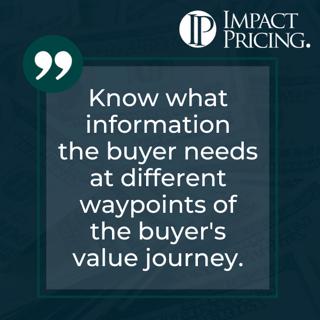
Pricing Table Topics: 9 of Spades – Know What Information the Buyer Needs
This one is the 9 of Spades from the Selling Value card deck. Buyers need different information depending on where they are in their own buying process. There's a map in the Selling Value book that talks about these different waypoints, but let's simplify it for the sake of this table topics and say, look, there's really two key phases in a buyer's decision process. First, they make a 'will I' decision. Then they make a 'which one' decision. When they're making a 'will I' decision, they're trying to ask, am I going to buy something in this product category or not? What they're really saying is, is the value of solving the problem worth the resources it's going to cost me to go solve that problem? What we want to give them at this point in time is information that says, here's the value of solving the problem. Here's the inherent value of our solution. Once they go on to make a 'which one' decision, they're now asking, is your product the right decision relative to your competitive alternatives? And now what they're looking for is relative value information. What's the value of your product relative to your competitor's product? We need to recognize where our buyers are in their buying process, and then make sure that we're giving them the information that they need to get through that stage. We hope you enjoyed this example of Pricing Table Topics. What you just heard was done without a script. If you want to get better at speaking about pricing and value, grab a deck of our cards, pick a card, read the saying, then talk for one to two minutes about what that card says. You will become a better speaker and expert. If you have any questions or feedback, please email me, mark@impactpricing.com. Now, go make an impact. Connect with Mark Stiving: Email: mark@impactpricing.com LinkedIn: https://www.linkedin.com/in/stiving/
25 Jan 20232min
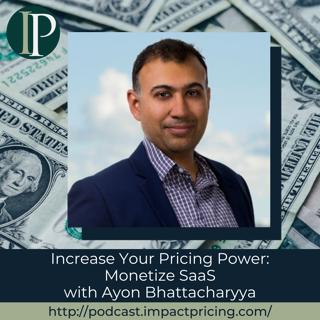
Increase Your Pricing Power: Monetize SaaS with Ayon Bhattacharyya
Ayon Bhattacharyya is the Founder of Biz Growth Spurt, a consulting firm based out of New Zealand. He has experienced pricing in half a dozen companies, and he's a passionate animal welfare advocate. In this episode, Ayon talks about the ins and outs of monetization. He also tells us a bit about his company, Biz Growth Spurt, and why you might be in need of their services. Why you have to check out today’s podcast: Learn about the three pillars of monetization and why you can’t only focus on one of them Know the difference between price metric and value metric and why it matters in getting more sales Understand why articulating value is essential in keeping and growing your customers “Understand your customers intimately and take the time to quantify your buyer personas so that you understand the use case of the value proposition, the willingness to pay the lifetime value, and the customer acquisition costs; so that you can better position and package to them and ultimately capture a fair portion of the value delivered to them.” – Ayon Bhattacharyya Topics Covered: 01:33 – How Ayon got into pricing 03:15 – How Ayon defines “monetization” 04:24 – What packaging means to Ayon, in relation to monetization 05:26 – What Ayon means by “feature differentiation” 06:30 – Why Ayon hates freemium 08:04 – Free trials vs. Freemium: why it is important which of the two fits your business more 11:07 – How to decide which features go to which packages 14:02 – Price metric vs Value metric 19:59 – Why positioning is an essential part of monetization 23:22 – Ayon’s key to monetization: the combination of packaging, pricing, and positioning 25:25 – Biz Growth Spurt: What they do and who their ideal customers are 28:50 – The meaning of “monetization” according to Ayon vs the meaning of “monetization” according to ProfitWell 31:54 – Ayon’s pricing advice 32:49 – Connect with Ayon Bhattacharyya Key Takeaways: “Once you have a deep understanding of your buyer personas, how they value your product, how they use your product, how your proposition aligns with their growth journey, then you can actually start putting your features into bundles. But you want to do that based on the level of importance of those features.” – Ayon Bhattacharyya “How you present the packages and the value messaging that you put on your website is so important. If they [the customers] understand that they're getting five times more value from the gold versus the silver, in their mind, it helps them to quantify that relative benefit of the upgrade and the potential ROI of an upgrade.” – Ayon Bhattacharyya “If the perceived value isn't there, if you aren't communicating it, if you don't have a strong brand presence, if your solution is so complex that customers don't understand the value that they get from it, then you know, you've just wasted all of this money on product development and marketing. – Ayon Bhattacharyya “Ideally, you want the messaging that you have on your packages is around the problem that you're solving for the customer. That's the key. It's not about the features. Those are just more internal to you. And often the customers don't get them.” – Ayon Bhattacharyya People / Resources Mentioned: Biz Growth Spurt: https://bizgrowthspurt.com/ Selling Value: How to Win More Deals at Higher Prices: https://www.amazon.com/Selling-Value-Deals-Higher-Prices/dp/1737655217 Connect with Ayon Bhattacharyya: LinkedIn: https://www.linkedin.com/in/valueconquer/ Email: ayon.b@bizgrowthspurt.com Connect with Mark Stiving: LinkedIn: https://www.linkedin.com/in/stiving/ Email: mailto:mark@impactpricing.com
23 Jan 202333min

Blogcast: A Price Negotiation Example
This is an Impact Pricing Blog published on December 14, 2022, turned into an audio podcast so you can listen on the go. Read Full Article Here: https://impactpricing.com/blog/a-price-negotiation-example/ If you have any feedback, definitely send it. You can reach us at mark@impactpricing.com. Now, go make an impact. Connect with Mark Stiving: Email: mark@impactpricing.com LinkedIn: https://www.linkedin.com/in/stiving/
20 Jan 20232min






















